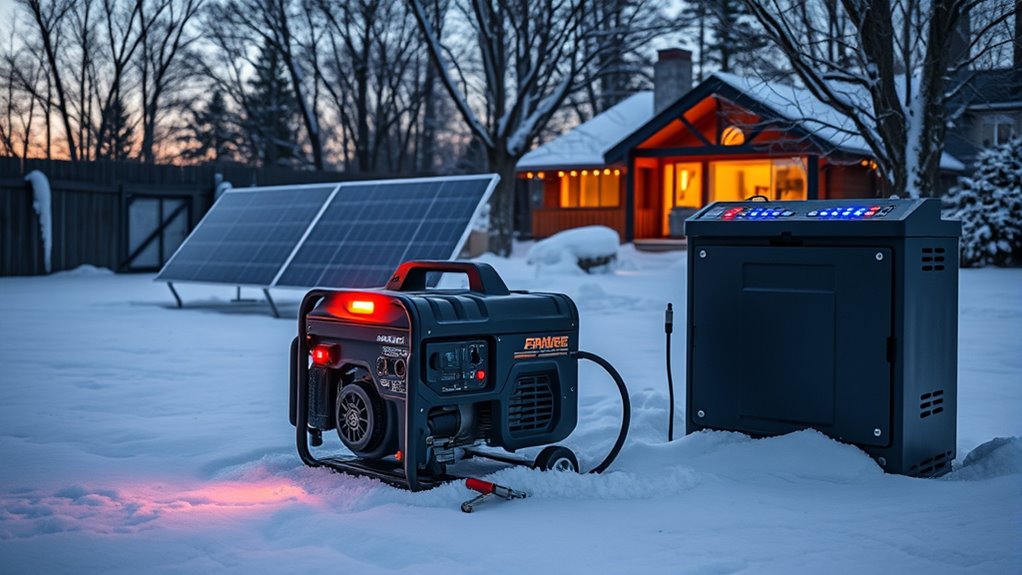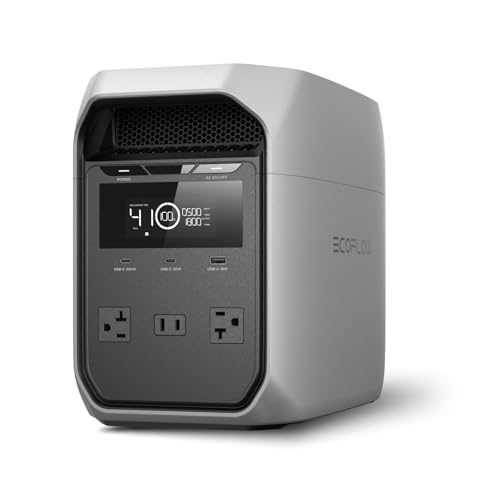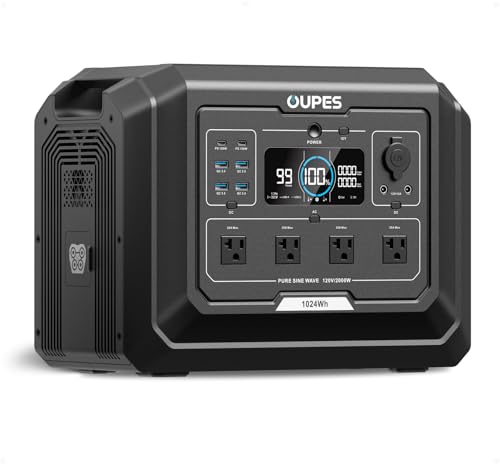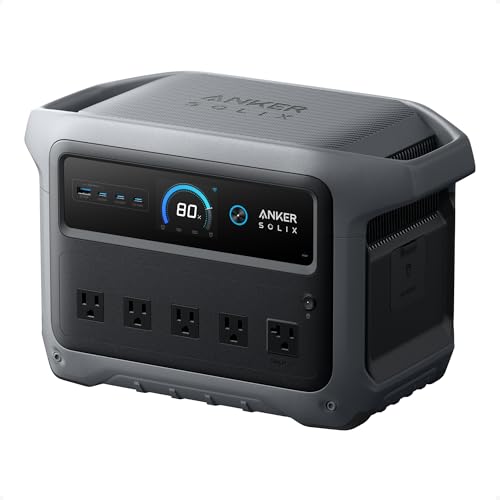If you’re looking for reliable winter backup power options, I recommend considering portable gas and multi-fuel generators like the Westinghouse 12500 Peak Watt Tri-Fuel, as well as compact power stations such as the Jackery HomePower 3000 and Explorer 300. Inverter generators like the WEN Quiet 6800-Watt and Ecoflow DELTA 2 are great for quiet outdoor use. There are also expandable systems like the OUPES Mega 1. Stick around as I’ll cover key features to help you choose the best solution for winter emergencies.
Key Takeaways
- Explore portable gas, multi-fuel, and inverter generators with high power output, fuel efficiency, and cold-weather safety features.
- Consider compact, lightweight power stations with fast recharge capabilities and expandable battery options for extended outages.
- Use quiet, EPA-compliant inverter generators to protect sensitive electronics and minimize noise during winter use.
- Prioritize models with dual-fuel options like propane and natural gas for winter fuel availability and safety.
- Ensure proper fuel storage solutions and safety measures to prevent freezing, leaks, and hazards in cold weather conditions.
Westinghouse 12500 Peak Watt Tri-Fuel Portable Generator
If you’re looking for a reliable backup power source during winter storms, the Westinghouse 12500 Peak Watt Tri-Fuel Portable Generator is an excellent choice. It offers up to 12,500 peak watts on gasoline, with versatile fuel options including propane and natural gas, ensuring you can refuel easily. The 457cc engine is built for durability, and safety features like automatic low oil shutdown and CO detection give peace of mind. With remote electric start, multiple outlets, and a 6.6-gallon tank providing up to 12 hours of runtime, it’s perfect for keeping essential appliances running during power outages. Its portability makes it convenient for home or on-the-go use.
Best For: homeowners and outdoor enthusiasts seeking a versatile, reliable portable generator for backup power during storms or outdoor activities.
Pros:
- Tri-fuel capability allows flexible fuel options including gasoline, propane, and natural gas.
- Up to 12 hours of runtime on a full tank for long-lasting power supply.
- Remote electric start with key fob for easy and convenient operation.
Cons:
- May be relatively heavy and bulky for some users to transport easily.
- Factory testing may leave residual oil or fuel odor on the unit.
- Higher price point compared to smaller or less feature-rich generators.
Jackery HomePower 3000 Portable Power Station with Solar Panels
The Jackery HomePower 3000 Portable Power Station with Solar Panels stands out as an excellent choice for homeowners and outdoor enthusiasts who need reliable backup power during winter storms and outages. With a 3600W continuous output and 3072Wh capacity, it can run essentials like fridges, fans, and WiFi for hours or days. Its compact, lightweight design makes it easy to transport, and it supports fast recharging via AC, DC, or solar panels—up to 80% in 9 hours. Equipped with advanced safety features and durable LiFePO4 batteries offering 4,000 cycles, it’s a dependable, eco-friendly solution for keeping your power on during harsh winter conditions.
Best For: homeowners, outdoor enthusiasts, and emergency preparedness individuals seeking reliable, portable backup power during storms, outages, or outdoor activities.
Pros:
- High capacity with 3600W continuous output and 3072Wh battery, suitable for running multiple essential devices for extended periods.
- Compact and lightweight design, making it easy to transport and store, with a honeycomb-style shell for added durability.
- Supports multiple charging options, including fast recharge via AC, DC, or solar panels, with solar compatibility up to 80% in 9 hours.
Cons:
- Power station and solar panels are shipped separately, potentially delaying full setup.
- Higher upfront cost compared to smaller portable power units, though offset by long-term durability and tax incentives.
- Limited to a maximum of 80% solar charge in 9 hours, which may be slower than some users prefer for rapid recharging.
WEN Quiet 6800-Watt Dual Fuel Portable Inverter Generator
When preparing for winter power outages, the WEN Quiet 6800-Watt Dual Fuel Portable Inverter Generator stands out as a reliable choice for those who need versatile, clean, and quiet energy. It delivers up to 6800 surge watts and 5100 rated watts on gasoline, or 6000 surge and 4500 rated watts on propane, making it suitable for essential appliances and electronics. Operating at just 64 decibels, it’s quiet enough for indoor or outdoor use. Its dual-fuel capability, automatic safety features, and multiple outlets—including USB ports and EV support—ensure flexibility and safety during winter emergencies. Its portability and efficiency make it a top contender for winter backup power.
Best For: individuals seeking a quiet, versatile, and reliable power source for backup during winter outages, camping, or outdoor activities.
Pros:
- Dual-fuel capability allows flexible operation with gasoline or propane, extending runtime and convenience.
- Low noise level at 64 decibels makes it suitable for indoor or quiet outdoor environments.
- Multiple outlets, including USB ports and EV-ready support, provide versatile connectivity options for various devices.
Cons:
- Heavier at 99.2 pounds, which may require assistance for portability.
- Higher price point compared to basic generators, reflecting its advanced features and safety systems.
- Limited runtime on a full tank (about 6 hours at half load), which may necessitate refueling during prolonged outages.
Jackery Portable Power Station Explorer 300
The Jackery Portable Power Station Explorer 300 stands out as an ideal backup power option for outdoor enthusiasts and those facing winter outages, thanks to its lightweight design and reliable performance. Weighing only 7.1 pounds, it’s perfect for camping, travel, and off-grid use. Its 293Wh lithium-ion battery supports multiple recharging methods, including wall outlets, car outlets, and solar panels, ensuring versatility. It delivers stable 300W power through two AC outlets and can charge up to six devices at once, from drones to laptops. With built-in safety features and efficient solar compatibility, it’s a dependable, portable solution to keep your essentials powered during cold weather.
Best For: outdoor enthusiasts, campers, and those needing reliable off-grid power during winter outages.
Pros:
- Lightweight and portable at only 7.1 pounds for easy transport
- Multiple recharging options including wall, car, and solar panels
- Supports charging up to six devices simultaneously with stable 300W power
Cons:
- Solar panel sold separately, adding to overall cost
- Limited to 293Wh capacity, which may not suffice for prolonged power needs
- No built-in Wi-Fi or app for remote monitoring
EF ECOFLOW Portable Power Station DELTA 2
If you’re looking for a reliable backup power source during winter outages, the EF ECOFLOW Portable Power Station DELTA 2 stands out with its expandable 1024Wh LiFePO4 battery that can be increased up to 3kWh, ensuring you have enough energy for essential appliances even in prolonged outages. It charges rapidly—0 to 80% in just 50 minutes—and supports solar input for eco-friendly recharging. With 1800W AC output and 15 outlets, it can power most household devices, making it ideal for home backup, camping, or off-grid living. Its durable design, safety features, and long-lasting battery make it a versatile and dependable winter power solution.
Best For: homeowners, campers, and off-grid enthusiasts seeking a reliable, expandable, and eco-friendly backup power solution during outages or outdoor adventures.
Pros:
- Rapid charging capabilities (0-80% in 50 minutes) for quick recharging during emergencies or travel.
- Expandable capacity up to 3kWh, providing ample power for essential appliances over longer periods.
- Supports solar input and multiple outlets, making it versatile for various off-grid and backup uses.
Cons:
- The 1800W AC output may not power high-wattage appliances like large HVAC systems or electric ovens.
- The initial capacity (1024Wh) might be limited for very long power outages without additional batteries.
- The price point may be higher compared to smaller or less feature-rich portable power stations.
DuroMax XP13000EH Portable Dual Fuel Generator
For homeowners seeking reliable power during winter storms and outages, the DuroMax XP13000EH Portable Dual Fuel Generator stands out with its impressive 13,000-watt surge capacity and dual fuel flexibility. It delivers 10,500 watts of continuous power, enough to run essential household appliances and central A/C systems. Powered by a durable 500cc engine, it can run on gasoline or propane, giving you flexibility in fuel options. Its heavy-duty all-metal frame and multiple outlets, including a transfer switch-ready 50-amp, ensure durability and safety. With features like electric start, mobility wheels, and a low oil shutdown, it’s a reliable choice for keeping your home powered during winter emergencies.
Best For: homeowners needing reliable, versatile backup power during winter storms, outages, or for outdoor events.
Pros:
- Offers a powerful 13,000-watt surge capacity and 10,500 watts of continuous power to run multiple household essentials simultaneously.
- Dual fuel capability allows operation on gasoline or propane for added convenience and flexibility.
- Heavy-duty all-metal construction with mobility features like wheels and foldable handle for easy transport and durability.
Cons:
- Relatively heavy at 234 pounds, which may require additional effort to move or position.
- Larger footprint (30L x 29W x 26H inches) could be cumbersome for limited storage spaces.
- Higher price point compared to smaller generators, reflecting its high power output and features.
Westinghouse 12500 Watt Dual Fuel Portable Generator
When preparing for winter outages, the Westinghouse 12500 Watt Dual Fuel Portable Generator stands out as a reliable choice, especially for those who need versatile power options. It delivers 9500 running watts on gasoline and 8500 on propane, with peak outputs of 12,500 and 11,200 watts respectively. Its 457cc engine ensures durability, and the dual fuel capability offers flexibility during fuel shortages. With up to 12 hours of runtime on a 6.6-gallon tank, it’s suitable for long outages. features like remote electric start, multiple outlets, and a digital display make it user-friendly. Plus, its 3-year warranty provides peace of mind during winter emergencies.
Best For: homeowners and emergency preparedness enthusiasts seeking a versatile, reliable generator for long outages and dual fuel convenience.
Pros:
- Offers high power output with 9500 running watts on gasoline and 8500 on propane, suitable for essential home appliances
- Dual fuel capability allows flexibility with fuel sources, especially during shortages or emergencies
- Remote electric start and digital display enhance ease of use and monitoring during power outages
Cons:
- Heavier and bulkier design may require additional setup space and effort to transport
- May produce residual oil or fuel odor due to factory testing and residual contents
- Limited to a 3-year warranty, which may be shorter than some premium models
ERAYAK 2400W Portable Inverter Generator for Home Use
The ERAYAK 2400W Portable Inverter Generator is an excellent choice for those seeking reliable backup power during winter emergencies, especially since its quiet operation guarantees it won’t disturb neighbors or family members. With 2400 peak watts and 1800 running watts, it reliably powers RVs, camping gear, or essential home devices. Its advanced inverter technology provides clean, stable electricity safe for sensitive electronics like laptops and medical devices. The eco mode optimizes fuel efficiency and reduces noise, allowing up to 16 hours of runtime on just 0.21 gallons per hour. Lightweight and portable, it’s easy to transport with compatible wheels and handles, making it perfect for any winter backup plan.
Best For: homeowners, RV owners, and campers seeking reliable, quiet backup power for outdoor and emergency use during winter months.
Pros:
- Provides clean, stable electricity safe for sensitive electronics like laptops and medical devices.
- Ultra-quiet operation at 52.5 dB, ideal for residential areas and campgrounds.
- Lightweight and portable design with compatible wheels and handles for easy transportation.
Cons:
- Limited runtime of up to 16 hours at 25% load, which may require additional fuel management for extended outages.
- Only 1800W of running power may not support larger or multiple heavy-duty appliances simultaneously.
- Battery and fuel consumption rates could be a concern for long-term use without frequent refueling.
EF ECOFLOW Portable Power Station DELTA 3 Classic, 1024Wh LiFePO4 Battery
If you’re looking for a reliable backup power source during winter outages, the EF ECOFLOW Portable Power Station DELTA 3 Classic stands out with its 1024Wh LiFePO4 battery and rapid charging capabilities. It provides 1800W of continuous power, surging up to 3600W, enough to run essentials like refrigerators, laptops, and small appliances. It recharges in just 45 minutes via ultra-fast X-Stream AC charging or around 2.5 hours with a 500W solar panel. Its durable LiFePO4 cells guarantee over a decade of use, while smart features like UPS protection and app control make it easy to manage. Compact and versatile, it’s an excellent winter backup solution.
Best For: those seeking a reliable, fast-charging portable power station for home backup, outdoor adventures, or emergency use during winter outages.
Pros:
- Rapid recharging with 45-minute X-Stream AC charging and efficient solar recharging in about 2.5 hours
- Durable LiFePO4 battery cells rated for over 10 years of daily use, ensuring long-term reliability
- Smart features like UPS protection and app control for easy monitoring and management
Cons:
- Maximum power output of 1800W may be insufficient for heavy-duty appliances without expansion
- Slightly lower capacity (1024Wh) compared to larger units, limiting run time for high-energy devices
- The need for additional solar panels or external power sources for full recharging capability
Portable Solar Generator with Foldable Solar Panel (Orange)
A portable solar generator with a foldable solar panel like the ZeroKor 300W is ideal for anyone seeking reliable backup power during winter outdoor activities or power outages. Its lightweight design (about 5.1 pounds) and compact size make it easy to carry and set up anywhere. The included 60W solar panel supports high-efficiency charging with MPPT technology, ensuring quick recharges even on cloudy days. It offers multiple outlets—AC, USB, and DC—to power smartphones, laptops, and small appliances. Plus, its built-in protections prevent overloads and overheating, making it a safe, versatile option for outdoor adventures or emergency use in cold weather.
Best For: outdoor enthusiasts, campers, and emergency preparedness individuals seeking a lightweight, efficient, and portable power solution for outdoor activities or power outages.
Pros:
- Compact and lightweight design (about 5.1 pounds) for easy portability and setup
- High-efficiency MPPT solar panel supports quick recharging even on cloudy days
- Multiple safety protections and built-in cooling fan ensure safe operation and durability
Cons:
- Supports devices only up to 300W; larger appliances may damage the unit
- Prolonged inactivity can trigger protection mode, requiring regular use or charging
- Not suitable as a sole emergency backup for extensive power needs due to limited capacity
EF ECOFLOW Portable Power Station DELTA Pro
When preparing for winter outages, the EF ECOFLOW Portable Power Station DELTA Pro stands out as an ideal choice for those who need reliable, expandable power on demand. Its 3600Wh LiFePO4 battery delivers robust backup for home use, camping, or emergencies. You can expand capacity up to 25kWh with extra batteries or smart generators. With 3600W AC outlets, expandable to 4500W, it powers heavy-duty devices indoors and outdoors. It supports fast recharging via wall outlets, solar, EV stations, or car outlets—getting fully charged in under 3 hours. Plus, the EcoFlow app allows remote monitoring, ensuring you stay in control during winter outages.
Best For: those seeking reliable, expandable power solutions for home backup, outdoor activities, or emergency preparedness during winter outages.
Pros:
- Large 3600Wh LiFePO4 battery with expandability up to 25kWh, suitable for heavy-duty devices.
- Fast recharging options including wall outlets, solar, EV stations, and car outlets, with a full charge in under 3 hours.
- Multiple output ports and the ability to pair units for higher power needs, offering versatile device compatibility.
Cons:
- Higher initial cost compared to smaller portable power stations.
- Bulkier and heavier, which may affect portability for some users.
- Requires compatible solar panels and extra batteries for full expandability, adding to overall investment.
Jackery Solar Generator 1000 v2 with Solar Panel
The Jackery Solar Generator 1000 v2 with Solar Panel stands out as an ideal backup power solution for outdoor enthusiasts and emergency preparedness, thanks to its high power capacity and fast charging capabilities. It delivers a 1500W AC output with a 3000W surge peak, allowing me to run multiple appliances like fridges and electric pots simultaneously. With a 1070Wh battery and various charging ports, I can charge devices quickly using PD 100W USB-C or solar power. Its lightweight design at 23.8 lbs makes it portable for camping or emergencies. Plus, the fast one-hour emergency charge via the Jackery App guarantees I stay powered when it matters most.
Best For: outdoor enthusiasts, campers, and emergency preparedness individuals seeking reliable, portable power with fast charging capabilities.
Pros:
- High power output (1500W AC, 3000W surge) suitable for multiple appliances simultaneously
- Fast one-hour emergency charging via the Jackery App for quick power restoration
- Durable LiFePO4 battery with over 4,000 charge cycles ensuring long-term reliability
Cons:
- Products like the solar panel and additional accessories ship separately, possibly delaying setup
- Limited to physical addresses for delivery, PO boxes are not supported
- The device may be heavy for some users despite its portable design
OUPES Mega 1 Portable Power Station (1024Wh)
If you’re seeking reliable backup power during winter outages, the OUPES Mega 1 Portable Power Station stands out with its 1024Wh LiFePO4 battery and fast-charging capabilities. It can be expanded to 5120Wh with an optional B2 battery, making it ideal for home backup, camping, or road trips. With a 2000W continuous AC output and 4500W peak, it runs high-watt appliances like refrigerators and CPAP machines effortlessly. Its dual charging options—fast 1400W or slower, battery-friendly 700W—ensure quick recharge. Plus, its versatile ports and smart app control make it a durable, cost-effective solution for maintaining power during winter storms.
Best For: households, campers, and travelers seeking reliable, expandable backup power during outages and outdoor adventures.
Pros:
- High capacity expandable to 5120Wh, suitable for large appliances and extended use
- Fast-charging options with a 20ms UPS switch for uninterrupted power during outages
- Versatile connectivity including multiple AC, USB, and DC ports with smart app control
Cons:
- Heavier and bulkier compared to smaller portable power options
- Higher initial cost despite being 20% more affordable than competitors
- Requires additional B2 battery for maximum expansion, which may add to setup complexity
MARBERO Portable Power Station 88Wh Camping Lithium Battery Solar Generator
For outdoor enthusiasts and emergency preppers, the MARBERO Portable Power Station 88Wh is an ideal choice because it offers fast, efficient charging with the included adapter and solar compatibility, making it perfect for off-grid situations or winter outages. It charges from 0 to 80% in just 2 hours and supports simultaneous device charging. Its compact, lightweight design (about the size of a DSLR) makes it easy to carry. With multiple output ports, including USB, USB-C PD, AC, and car socket, it powers phones, laptops, small appliances, and even a car fridge. The built-in flashlight with SOS mode adds safety for emergencies.
Best For: outdoor enthusiasts, emergency preppers, and anyone needing portable, versatile power on the go.
Pros:
- Fast charging from 0 to 80% in just 2 hours with included adapter, ideal for quick power-ups.
- Compatible with solar panels and supports multiple device charging simultaneously, enhancing outdoor and off-grid usability.
- Compact, lightweight design with multiple output ports and built-in safety features, making it easy and safe to carry and use in various settings.
Cons:
- Limited capacity at 88Wh, which may not be sufficient for longer power needs or high-energy appliances.
- Only compatible with MARBERO solar panels (30W or 60W), restricting solar charging options.
- Brightness and runtime of the flashlight may be limited for extended emergency use in very dark environments.
Anker SOLIX C1000 Gen 2 Portable Power Station
When preparing for winter power outages, the Anker SOLIX C1000 Gen 2 Portable Power Station stands out with its rapid recharge capability, fully recharging in just 49 minutes using HyperFlash tech. It delivers a robust 2,000W continuous power, peaking at 3,000W, and can run up to 10 devices simultaneously, making it ideal for emergency backup or off-grid living. Its 1,024Wh battery supports solar recharging and is built for durability, with a lifespan of over 4,000 cycles. Compact and lightweight, it’s easy to transport anywhere—your home, RV, or campsite—ensuring you stay powered during even the coldest, toughest winter conditions.
Best For: those seeking a reliable, fast-charging portable power station for emergency backup, outdoor adventures, or off-grid living during winter or any season.
Pros:
- Rapid recharge in just 49 minutes with HyperFlash technology, ensuring quick power availability.
- High capacity of 1,024Wh and 2,000W continuous output, supporting multiple devices simultaneously.
- Durable design with over 4,000 charging cycles and a 10-year lifespan, ideal for long-term use.
Cons:
- Relatively heavy and may require effort to carry over long distances despite being lightweight for its capacity.
- Solar recharging requires up to 1.8 hours with 600W input, which may be slow in low-sunlight conditions.
- Higher initial cost compared to smaller or less powerful portable power options.
Factors to Consider When Choosing a Winter Backup Generator Alternative
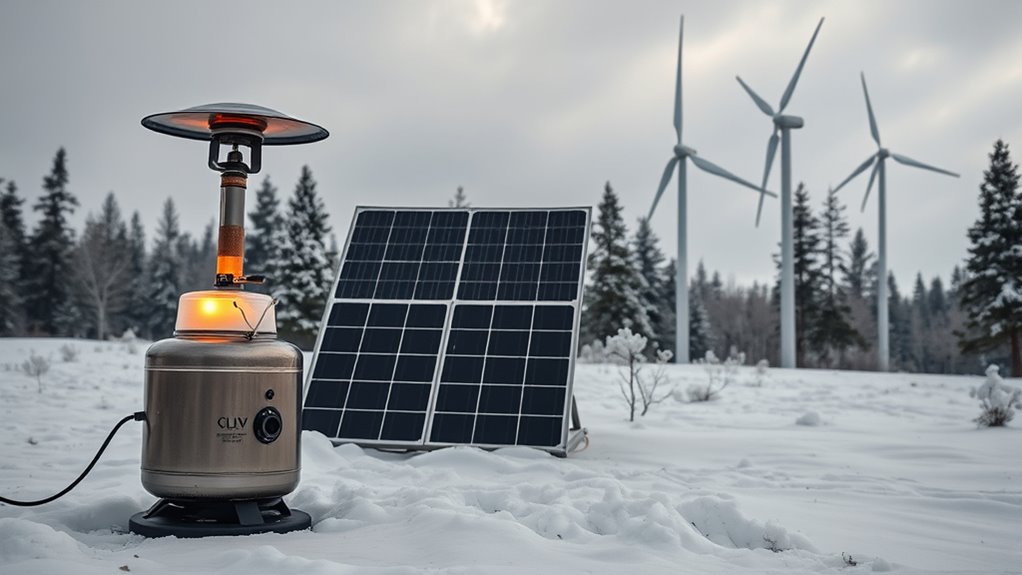
When selecting a winter backup generator alternative, I focus on several key factors to guarantee it meets my needs. I consider the power capacity required, the availability of fuel types, and how portable and space-efficient it is. Additionally, I look at noise levels, emissions, and how long it can run efficiently during outages.
Power Capacity Needs
Choosing the right winter backup generator starts with understanding your power capacity needs. First, I recommend totaling the wattage of all essential appliances and devices you want to power during an outage. This includes both running watts and peak watts, especially for devices with high startup surges. It’s important to select a generator that can comfortably handle these surges without strain. I also consider how long I might need backup power, so I look for units with enough fuel capacity or battery life for extended outages. Additionally, I think ahead about future needs or added devices, opting for a generator with expandable capacity or higher initial wattage. Ultimately, I make certain the generator can operate efficiently in cold conditions, providing reliable power when it’s needed most.
Fuel Type Availability
Have you considered whether the fuel type your generator requires will be reliably available during winter? Ensuring consistent access to fuel—whether gasoline, propane, or natural gas—is essential. In cold weather, fuel storage options should be safe and resistant to freezing or leaks; proper containers and insulation help. It’s also important to think about fuel efficiency and runtime, especially during prolonged outages, so your generator can keep running without frequent refueling. If possible, choose a model that can switch between multiple fuel sources for added flexibility. Additionally, be aware of environmental and safety regulations regarding fuel storage and handling, as winter conditions can complicate these issues. Confirming fuel availability and safety measures helps prevent unexpected power loss during cold spells.
Portability and Size
A portable generator’s size and weight play a essential role in how easily you can move and store it during winter emergencies or outdoor activities. A compact, lightweight generator is much easier to transport and store, especially in tight spaces or limited storage areas. Features like wheels, handles, or foldable components further boost ease of movement, making setup quick and hassle-free. The weight directly affects how easily one person can carry or maneuver the unit, which is critical during urgent situations. Choosing a generator with a smaller footprint allows for faster deployment and effortless relocation when conditions change. Overall, prioritizing portability and size ensures you’ll have reliable power without the burden of bulky equipment, especially when you’re dealing with cold weather challenges.
Noise and Emissions
When selecting a winter backup generator, paying attention to noise levels and emissions is essential for safety and comfort. Generators with lower decibel ratings, around 52-64 dB, operate more quietly, minimizing disruption during cold weather outages. Inverter generators are a great choice—they emit fewer fumes and run more quietly than traditional open-frame models. Proper placement away from living areas and using sound-dampening enclosures can further reduce noise pollution. Emissions standards like EPA compliance ensure the generator produces fewer harmful pollutants, making indoor or enclosed space use safer. Additionally, dual-fuel generators that run on propane offer cleaner burning options, especially in winter when cold weather can increase emissions from gasoline. Prioritizing quiet operation and lower emissions improves safety, comfort, and environmental impact during power outages.
Runtime and Efficiency
Choosing a backup generator for winter requires careful consideration of runtime and efficiency to guarantee your essential devices stay powered throughout outages. Longer runtime on a full tank or battery capacity means you can depend on your system during extended outages without frequent refueling or recharging. High fuel efficiency and low consumption rates help maximize operational time while keeping costs and emissions down. Features like automatic low oil shutdown and eco-modes further optimize runtime by reducing unnecessary fuel use and maintenance needs. Battery-based options with large capacities, such as 3000Wh or more, can provide hours of backup power without refueling. Additionally, efficient energy conversion and minimal power loss during transfer ensure your system remains reliable and effective when you need it most.
Safety Features Included
Safety features are essential considerations when selecting a winter backup generator, as they help protect both users and equipment during outages. Automatic low oil shutdown prevents engine damage by turning off the generator if oil levels drop too low. Carbon monoxide (CO) detection is vital for alerting users to dangerous fumes, especially in cold weather when windows may be closed. GFCI outlets with rubber covers reduce the risk of electrical shock and short circuits in damp conditions. Transfer switch-ready outlets enable safe connection to your home’s electrical system without backfeeding, reducing fire hazards. Overload protection and circuit breakers guard against power surges that could damage devices or the generator. Built-in safety sensors, like CO shutdown systems and automatic shutoffs for low fuel or oil, further enhance operational safety during extended use.
Compatibility With Devices
Ensuring your backup generator alternative is compatible with your devices is essential for reliable power during winter outages. First, check that it provides enough wattage and amperage to run all your essential appliances simultaneously. Make sure the output includes the correct plug types and voltage levels to match your devices and electronics. If you have sensitive electronics like laptops or medical devices, look for a generator that delivers clean, stable power, such as a pure sine wave output, to prevent damage. It’s also important to verify the generator can handle surge demands and has safety features like overload protection and circuit breakers. finally, consider how easily you can recharge or refuel the power source during extended outages, ensuring continuous and dependable operation.
Budget Considerations
When selecting a winter backup generator, evaluating your budget is the first step toward making a smart choice. I recommend starting by setting a clear budget range, as costs can vary widely—from under $500 for small inverter models to over $10,000 for large dual-fuel units. Don’t forget to take into account long-term expenses like fuel, maintenance, and repairs, which can add up over time. Make sure to assess your power needs carefully to avoid overspending on unnecessary capacity or underestimating requirements, which can lead to higher costs or insufficient backup. Additionally, explore financing options, discounts, or government incentives, such as tax credits for energy-efficient models, to lower initial expenses. Finally, balance your budget with features, durability, and warranty coverage to ensure a reliable, cost-effective investment.
Frequently Asked Questions
How Long Can Portable Power Stations Run During Winter Outages?
During winter outages, I find portable power stations typically run for about 4 to 8 hours on a full charge, depending on the device’s capacity and what I’m powering. If I need longer, I keep extra batteries or a solar panel handy to recharge. It’s essential to manage power consumption carefully and prioritize critical devices, so I stay comfortable and safe until the power is restored.
Are Solar Generators Effective in Overcast or Snowy Winter Conditions?
Yes, solar generators can be effective in overcast or snowy winter conditions, but their performance drops. I’ve found they work best with consistent sunlight, so cloudy days or snow-covered panels reduce their efficiency. To keep power reliable, I recommend combining solar with other backup options, like a small generator or battery pack, ensuring you stay powered even when sunlight is limited.
What Safety Precautions Are Needed When Using Dual Fuel Generators Outdoors?
Did you know that improper use of outdoor generators causes over 50% of related accidents? When using dual fuel generators outdoors, I always guarantee proper ventilation to prevent carbon monoxide buildup. I keep a safe distance from windows and vents, wear gloves and eye protection, and check for leaks or spills before starting. These precautions help me stay safe while keeping my power running during winter storms.
Can Portable Power Stations Power All Essential Home Appliances Simultaneously?
Portable power stations can’t typically power all essential home appliances simultaneously because they have limited wattage capacity. I recommend checking your appliances’ power requirements and comparing them to the station’s surge and continuous wattage. For essential devices, prioritizing and possibly using multiple units helps. Remember, these stations are great for emergencies but might not run everything at once, so planning your power needs is key.
How Do Cold Temperatures Affect the Battery Life of Backup Generators?
Cold temperatures can turn your backup generator’s battery into a sluggish, less reliable partner. I’ve seen batteries struggle like frozen ponds, losing their charge faster and taking longer to start. As the mercury drops, chemical reactions slow down, reducing capacity and lifespan. To keep things running smoothly, I recommend storing your generator indoors or using a battery warmer—making sure it’s ready to spring into action when winter hits hard.
Conclusion
No matter which backup option you choose, prioritize reliability, portability, and power capacity. Think about your needs, consider your budget, and weigh your options carefully. Whether it’s a portable generator or a power station, guarantee it’s ready to keep your essentials running, your comfort maintained, and your peace of mind restored. Prepare now, stay safe, and keep the power flowing—because in winter, staying connected matters most.

